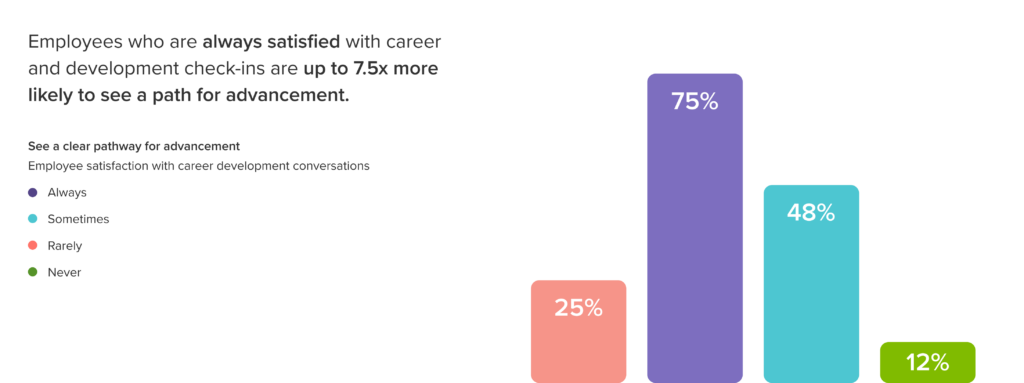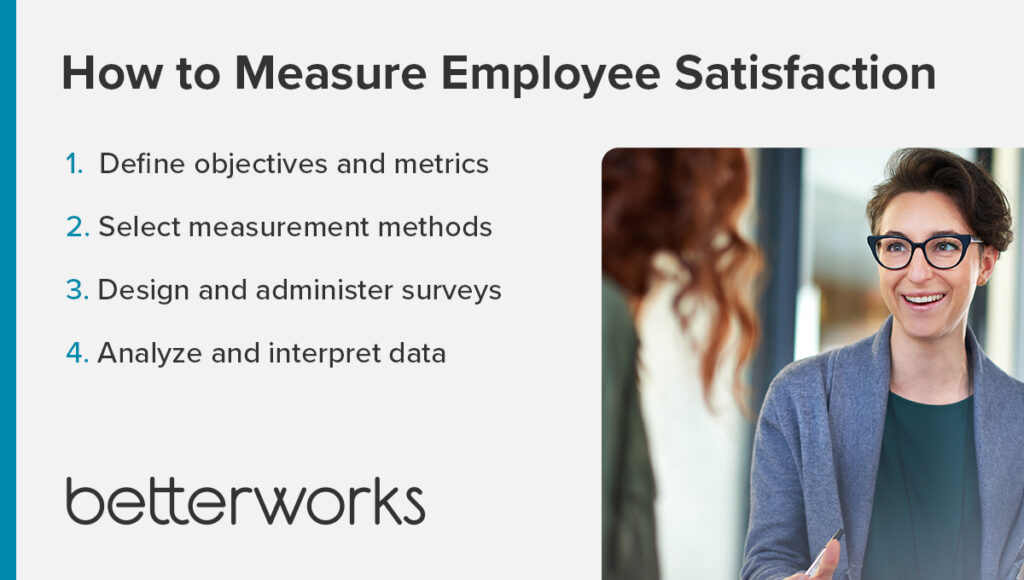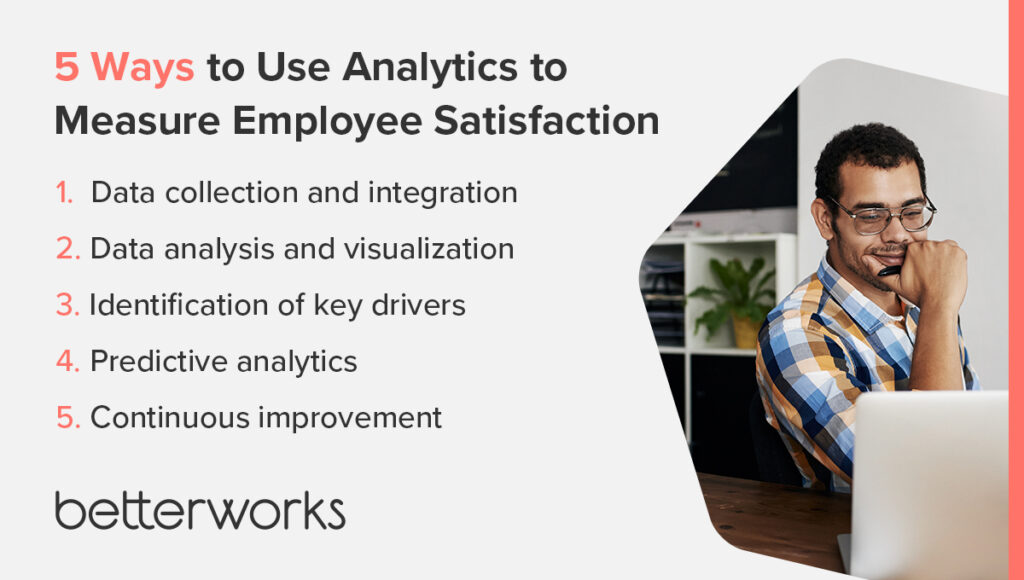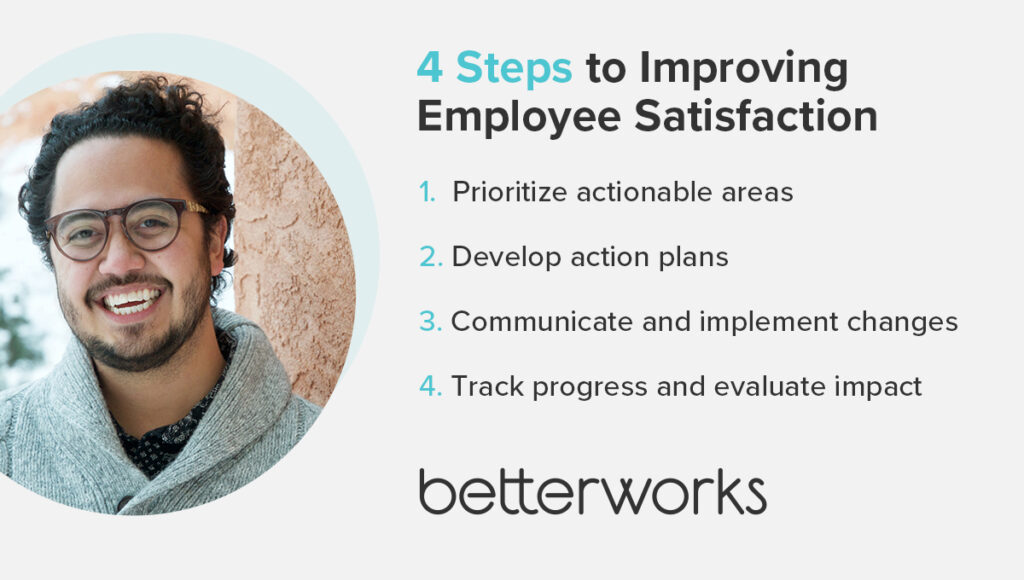- Why employee satisfaction matters
- Changing sentiments: A challenge in measuring employee satisfaction
- How to measure employee satisfaction
- The role of analytics in employee satisfaction measurement
- How to improve employee satisfaction and drive engagement and productivity
- Measure employee satisfaction to drive change
Measuring employee satisfaction rates helps HR teams understand the workforce’s overall happiness in their roles and in the company — which can be a strong predictor of retention. However, collecting survey data once or twice a year and running basic reports isn’t enough.
To truly drive positive change, organizations need HR analytics to uncover underlying issues that could be affecting employee satisfaction. Analytics help companies proactively identify patterns, trends, and correlations within data. Instead of a surface-level observation, you can pinpoint root causes of dissatisfaction, such as poor communication, work-life balance, or career development.
This knowledge helps your company take targeted action, ultimately improving employee engagement, productivity, and organizational success.
Discover why employee satisfaction matters, how to measure it, and what it takes to apply employee satisfaction metrics to improve employee retention.
Why employee satisfaction matters
Satisfied employees are more engaged and motivated. When employees feel valued, supported, and fulfilled in their roles, they’re more likely to go above and beyond their job requirements. They exhibit higher levels of productivity, creativity, and innovation, leading to improved business outcomes. Satisfied employees also tend to have lower absenteeism rates and higher retention rates, reducing recruitment and training costs for the organization.
When employees are satisfied with their career and development check-ins with managers, for example, they’re 7.5 times more likely to see a path for advancement within the company, according to our 2023 State of Performance Enablement report. They’re also far more likely to report always feeling engaged and productive. Satisfaction in just one area can have a multiplier effect across the board, improving overall talent outcomes.

Moreover, employee satisfaction fosters a positive work culture and enhances teamwork. When employees feel satisfied and supported, they’re more likely to collaborate, communicate effectively, and contribute to a harmonious work environment. This, in turn, leads to higher employee morale, reduced conflicts, and increased overall job satisfaction.
Finally, employee satisfaction directly affects customer satisfaction. Happy employees are more likely to provide exceptional customer service, resulting in increased customer loyalty and a positive brand reputation. Satisfied employees act as brand ambassadors, promoting your organization’s values and delivering a superior customer experience, aided by contact center AI to optimize their support processes.
Changing sentiments: A challenge in measuring employee satisfaction
Employee satisfaction is challenging to measure because it typically represents how an employee feels at that moment during the survey process. But “that can always change,” says I/O psychologist and Betterworks Program Strategy Director Caitlin Collins. “I might score high today on an employee satisfaction score, but maybe there’s a conflict that happens tomorrow where my employee satisfaction dips.”
Employers typically ask questions related to satisfaction during longer employee engagement surveys or an employee satisfaction index (ESI) and often only collect this data once per year. But that’s just a snapshot in time, and your results will be heavily influenced by what’s going on in the organization at the time.
“If an organization went through a lot of layoffs,” Collins says, “your satisfaction scores are going to be really low — much lower than they would have been the day before the layoffs happened.” To get a better sense of how team members feel about their jobs and the employee experience, she says, you need to assess satisfaction scores more often.
But people get survey fatigue from too-frequent or too-long surveys — especially if they answer the same questions over and over without seeing you act on the results.
If you want to get the real state of employee happiness and satisfaction at work, you need an intentional plan for tracking what employees feel throughout the year. “It’s a valuable sentiment to capture,” Collins says. “You just have to be mindful about when and how you’re capturing it.”
How to measure employee satisfaction
With a clear plan and targeted surveys, you can collect honest feedback from employees and calculate a score that shows you the overall level of satisfaction in your workforce. Here are four steps to building an effective process for measuring employee satisfaction.
Define objectives and metrics
Don’t begin assessing employee satisfaction unless you have a specific goal in mind. Think about what elements of the employee experience are most important to measure. Maybe that’s specific to whether people are satisfied with their jobs, Collins says, which is most common. Or maybe you’re looking for an employee net promoter score (eNPS) or whether team members might suggest you as an employer to friends and family.
Whatever aspect of employee satisfaction you decide is most important to assess, try to keep it streamlined enough to gauge using one or two very simple questions.
“If you want to get the real state of employee happiness and satisfaction at work, you need an intentional plan for tracking what employees feel throughout the year. It’s a valuable sentiment to capture. You just have to be mindful about when and how you’re capturing it.”
caitlin collins, program strategy director, betterworks
Select measurement methods
Choose the best methods for collecting employee feedback. This can include traditional methods like standard surveys as well as more innovative approaches, such as sentiment analysis and pulse surveys. If you want to collect more data points over time, team members may respond best to pulse surveys or quick rating systems.
Design your measurement methods to protect employee confidentiality. Employees are more likely to give you honest feedback if they know their responses are anonymous.
Design and administer surveys
Create surveys that are easy to understand and ask the right questions that are relevant to what you’re trying to measure. Keep the questions short and targeted. “You can get more of an average over time if it takes one second for somebody to complete it and it’s done,” Collins says.
Include an open-ended “suggestion box” for a more complete picture of employee satisfaction and to learn more about what employees want from you to help drive a better experience.
For the best results, Collins says, use a mix of quick pulse surveys throughout the year to track changes in sentiment and one longer annual survey to ask deeper questions. In a longer survey, you can dig deeper into why employees feel the way they do. Consider asking questions related to company culture, flexible working arrangements, or mental health support, for example.
Analyze and interpret data
After you collect the data, look at it closely to find any common themes, patterns, or areas that need improvement. Use statistical analysis methods to measure how satisfied people are overall and to track trends and changes in satisfaction levels.
Assess the data for connections and relationships between the factors related to employee satisfaction and changes in your score. This process can help you identify the specific areas where you can make changes to increase employee happiness at work.

The role of analytics in employee satisfaction measurement
Use analytics to gain proactive insights into employee satisfaction metrics. A deeper dive into the data takes you beyond surface-level assessments to uncover underlying issues that may affect overall satisfaction, engagement, productivity, and more.
This deeper understanding enables you to take targeted actions to address specific areas of concern, implement effective strategies, and make data-driven decisions to promote employee happiness across the organization.
Here are five ways to use analytics to take a strategic approach to applying employee satisfaction data.
Data collection and integration
Analytics helps in collecting and integrating data from various sources. Besides surveys, you can pull data from systems of work, such as your performance management software, employee feedback platforms, collaboration tools, and channels such as Slack or Teams.
Aggregating and analyzing this diverse data provides you with a more complete understanding of employee sentiment and satisfaction levels. This approach allows for a holistic view of employee satisfaction, enabling you to identify trends, patterns, and correlations across different data sources.
Data analysis and visualization
All data tells a story, and analytics can help you discover what that story is. By analyzing and summarizing the data, companies can identify key trends, patterns, and insights that shape the narrative. Visualizing the data through charts, graphs, and dashboards makes it easier to understand and communicate the story effectively. This visual representation allows stakeholders to quickly grasp the overall sentiment, identify areas of concern, and track progress over time.
By presenting the data in a clear and concise manner, analytics enables organizations to convey the story behind employee satisfaction, facilitating informed decision-making and driving meaningful actions to enhance employee engagement and satisfaction.
Identification of key drivers
By examining various factors and their relationship to employee satisfaction, you can determine which aspects of the employee experience have the greatest impact on their satisfaction levels. Examples of key drivers include pay and benefits, long-term career growth opportunities, work-life balance, leadership effectiveness, and recognition and rewards.
If your analysis consistently shows a strong correlation between a particular factor and employee satisfaction across different data sets and times, that indicates that the factor is a significant driver you can prioritize for continuing improvement.
Predictive analytics
Applying predictive analytics to employee satisfaction data involves using historical data and statistical models to forecast future satisfaction levels. AI plays a crucial role in this process by leveraging machine learning algorithms to analyze large volumes of data and identify patterns and trends.
By training AI models on historical employee satisfaction data and relevant predictors, such as performance metrics, engagement levels, and demographic information, you can predict future satisfaction levels for individual employees or the entire workforce.
AI algorithms also can identify the key factors that influence satisfaction, enabling you to take proactive measures to address potential issues and improve overall employee satisfaction. This predictive capability helps HR leaders make data-driven decisions and implement targeted interventions to enhance employee engagement and satisfaction.
Continuous improvement
Applying analytics to employee satisfaction data can help create a road map for continuous improvement. By analyzing the data, you can identify areas of strength and areas that need improvement.
With this information, your team can prioritize and focus your efforts on specific areas that have the greatest impact on improving satisfaction. Analytics also can help track progress over time, allowing you to measure the effectiveness of your initiatives and make data-driven adjustments as needed.

How to improve employee satisfaction and drive engagement and productivity
The most important factor in measuring employee satisfaction is your plan to do something about what you learn from the results. Data collection is insufficient if you don’t have a plan for making changes that improve employee satisfaction — and people will pick up on that.
“Does it mean something?” Collins asks. “Are you going to share the results back with employees — and do something about it? Otherwise, don’t do it at all.”
Designing and executing an action plan can be challenging, but it’s key to carrying out a successful employee satisfaction strategy. Check out these four steps to acting on the story told by your data.
Prioritize actionable areas
Prioritize the areas that require immediate attention based on the survey results. Consider the scope of the impact and the feasibility of implementing changes when prioritizing actions.
By focusing on the factors that have the greatest influence on employee satisfaction, you can allocate resources effectively and make targeted improvements that will have the most significant impact on overall satisfaction levels. For example, if you find pay and benefits to be a major driver of satisfaction, you may prioritize actions such as salary adjustments or improved benefits packages.
Develop action plans
Develop specific action plans to address the identified areas of improvement. Involve relevant stakeholders, such as managers and employees, in the process by seeking their input and feedback through surveys, focus groups, or one-on-one discussions. This helps you gain a deeper understanding of the underlying reasons behind satisfaction levels and gather insights on potential solutions.
Set clear goals and outline the steps needed to achieve them. Make sure that the action plans are realistic, achievable, and aligned with the organization’s overall strategy.
For example, let’s say that employees are frustrated because they have too many meetings that inhibit their ability to get work done efficiently. Improving productivity may be one of your goals. You might plan to:
- Designate certain days or time blocks as “meeting-free”
- Implement a flexible work schedule that includes options to work remotely so that employees face fewer interruptions than they would in an office
- Create a decision tree to help meeting organizers decide whom they need to invite, who can be optional, and who doesn’t need to participate
- Develop a system for communicating meeting highlights or outcomes so that only the people who are integral to the meeting need to participate
By implementing these steps, you can create a workplace that empowers and motivates employees, promotes productivity, and ultimately improves employee satisfaction.
Communicate and implement changes
Communicate the survey findings and action plans to employees. Transparently explain the rationale behind the changes and how you plan to address the issues you’ve identified.
You don’t have to share every detail of your plan with the entire workforce, but communicating it broadly on the front end helps employees understand what changes are ahead and shows that you took their perspectives and ideas into account.
Make sure that your changes are effectively communicated and consistently implemented across the organization. If one of your planned changes is to roll out a mentorship program, for example, create a series of emails or other forms of communication or content explaining what the program entails and how to get involved. Share this information directly with employees and through managers to make sure everyone has the chance to participate.
Track progress and evaluate impact
Continuously track the progress of your changes and evaluate their impact on employee satisfaction and engagement. Regularly collect feedback from employees to re-assess their satisfaction levels and gather insights on the effectiveness of the initiatives. Use this feedback to make necessary adjustments and improvements to the action plans. Treat this as an ongoing process of discovery and improvement.
Say you initially found that employees were dissatisfied with your static annual review process, so you set a plan for implementing fluid performance check-ins instead. Additional surveys over time can help you refine this process and continue to fill gaps until people feel supported by your new process. Additional steps might include increased employee autonomy concerning goal-setting and improved training to increase manager effectiveness as performance coaches.

Measure employee satisfaction to drive change
By implementing effective measurement strategies such as regular surveys, feedback mechanisms, and data analysis, organizations can gain valuable insights into employees’ needs, concerns, and aspirations. This data-driven approach enables HR leaders and managers to make informed decisions, refine action plans, and create a work environment that fosters employee engagement and satisfaction.
Want to learn more? Check out our guide to creating an employee satisfaction survey.
Increase employee satisfaction by supporting career development



